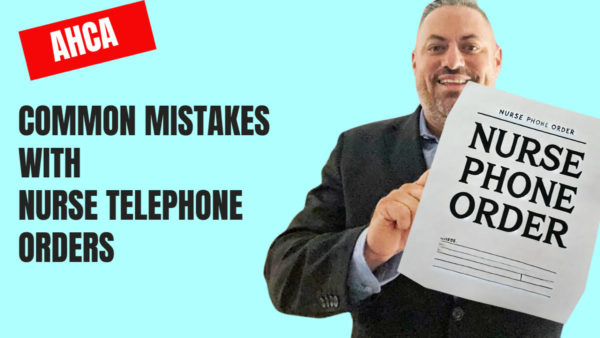AHCA Alert: Avoid Common Mistakes with Nurse Telephone Orders in Assisted Living
Handling nurse telephone orders in assisted living facilities is a routine task, but it’s one that must be carefully managed to stay compliant with AHCA regulations. Whether your facility has its own nursing staff or relies on home health nurses calling in orders, proper documentation and follow-up are crucial. AHCA’s Regulation 59A-36.008(5) outlines specific requirements for handling these telephone orders. Let’s dive into how to avoid common mistakes and ensure your facility stays compliant.
Key Requirements of AHCA Regulation 59A-36.008(5)
1. Nurse Telephone Orders
Whether the facility has its own nurses or relies on home health nurses, a licensed nurse can take medication orders by phone from a healthcare provider. This allows for flexibility in ensuring residents receive timely care.
2. Immediate Documentation
Once a medication order is taken over the phone, it must be promptly documented in the resident’s Medication Observation Record (MOR). This step is crucial to prevent any errors in medication assistance .
3. Obtaining a Written Medication Order
After taking the telephone order, the facility must obtain a written medication order from the healthcare provider within 10 working days. The order can be submitted via fax or electronically, as long as it is signed by the provider.
4. What If You Don’t Receive the Written Order?
If the written order is not received within 10 days, follow up with the provider and make sure to document these efforts. This demonstrates that your facility is actively working to meet compliance standards.
Common Mistakes to Avoid
1. Failing to Document Telephone Orders Immediately
– One of the biggest compliance issues is failing to promptly document telephone orders. Whether the nurse is in-house or from a home health agency, the order must be recorded in the resident’s MOR as soon as it is received. Delaying this step can lead to medication errors and non-compliance with AHCA regulations.
2. Not Following Up on Written Orders
Some facilities may overlook the 10-day requirement for obtaining a written medication order after a telephone order is received. This could lead to serious compliance issues during an AHCA inspection. Establish a system to track these deadlines and ensure written orders are secured on time.
3. Improper Storage of Written Orders
Once you receive the written, faxed, or electronic copy of the medication order, it must be properly stored in the resident’s file. Misplacing or failing to organize these orders can create confusion and gaps in your compliance records.
Best Practices for Compliance
1. Train Your Nursing and Administrative Staff
Make sure both in-house nurses and any home health nurses understand the importance of documenting telephone orders immediately. Include training on AHCA’s requirements so everyone is on the same page.
2. Set Up Reminders for Written Orders
Use a tracking system or reminders to ensure the written medication order is requested and received within 10 working days. This can be automated with an Electronic Health Records (EHR) system or a simple manual checklist.
3. Audit Medication Records Regularly
Regular audits of your medication records will help identify any missing or improperly documented telephone orders. These audits can catch potential compliance issues before they become problems during an AHCA inspection.
Conclusion
Properly handling nurse telephone orders is essential to staying compliant with **AHCA’s Regulation 59A-36.008(5)**. Whether your facility has its own nurses or works with home health agencies, the key is to ensure that all orders are documented immediately and that written verification is obtained within the required timeframe. By avoiding common mistakes and following best practices, you can ensure your facility remains in compliance and provides safe, effective care for your residents.
